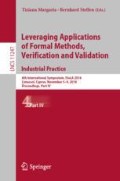Abstract
The paper presents a brief overview of the SMEDL monitoring system that provides flexible and scalable deployment of monitors for large-scale software. The SMEDL specification language expresses monitoring logic as a collection of monitoring objects and monitoring architecture as flows of information between the monitored system and monitoring objects. The system supports synchronous as well as asynchronous deployment of monitoring objects and dynamic instantiation of monitoring objects on demand. The application of the SMEDL system for the monitoring of a target tracking application is briefly discussed.
This work is supported in part by the Air Force Research Laboratory (AFRL) and Defense Advanced Research Projects Agency (DARPA) under contract FA8750-16-C-0007 and by ONR SBIR contract N00014-15-C-0126.
Access this chapter
Tax calculation will be finalised at checkout
Purchases are for personal use only
Notes
- 1.
SMEDL stands for Scenario-based Meta-Event Definition Language.
References
NATO ground moving target indicator format - STANAG 4607, edition 2. https://standards.globalspec.com/std/1300603/nato-stanag-4607. Accessed 9 May 2018, September 2010
Coady, Y., Kiczales, G., Feeley, M., Smolyn, G.: Using aspectC to improve the modularity of path-specific customization in operating system code. SIGSOFT Softw. Eng. Notes 26(5), 88–98 (2001)
Sokolsky, O., Havelund, K., Lee, I.: Introduction to the special section on runtime verification. Softw. Tools Technol. Transf. 14(3), 243–247 (2012)
Zhang, T., Gebhard, P., Sokolsky, O.: SMEDL: combining synchronous and asynchronous monitoring. In: Falcone, Y., Sánchez, C. (eds.) RV 2016. LNCS, vol. 10012, pp. 482–490. Springer, Cham (2016). https://doi.org/10.1007/978-3-319-46982-9_32
Author information
Authors and Affiliations
Corresponding author
Editor information
Editors and Affiliations
Rights and permissions
Copyright information
© 2018 Springer Nature Switzerland AG
About this paper
Cite this paper
Zhang, T., Eakman, G., Lee, I., Sokolsky, O. (2018). Flexible Monitor Deployment for Runtime Verification of Large Scale Software. In: Margaria, T., Steffen, B. (eds) Leveraging Applications of Formal Methods, Verification and Validation. Industrial Practice. ISoLA 2018. Lecture Notes in Computer Science(), vol 11247. Springer, Cham. https://doi.org/10.1007/978-3-030-03427-6_6
Download citation
DOI: https://doi.org/10.1007/978-3-030-03427-6_6
Published:
Publisher Name: Springer, Cham
Print ISBN: 978-3-030-03426-9
Online ISBN: 978-3-030-03427-6
eBook Packages: Computer ScienceComputer Science (R0)

